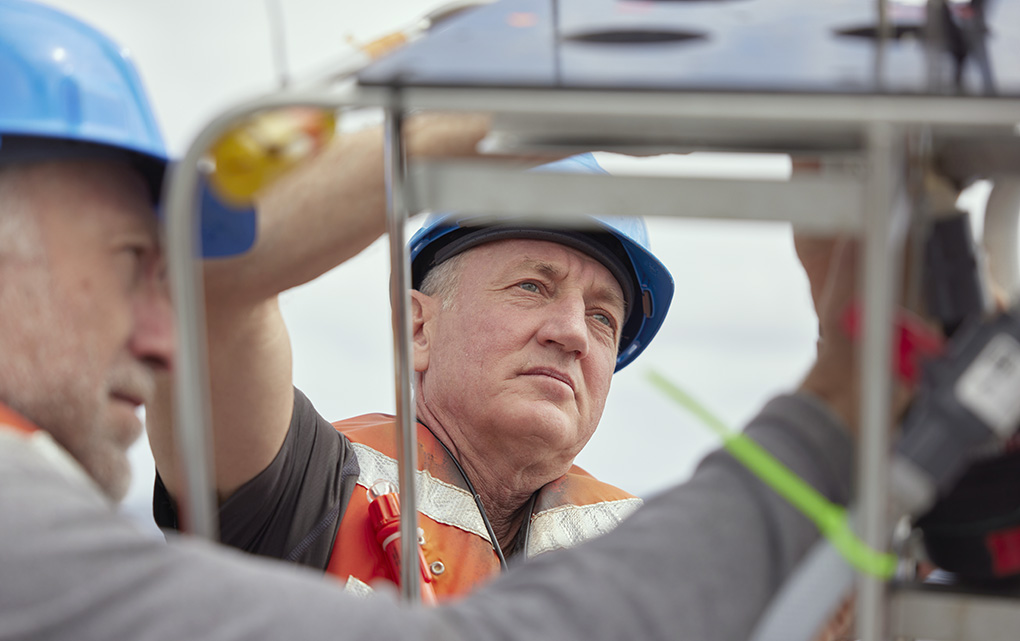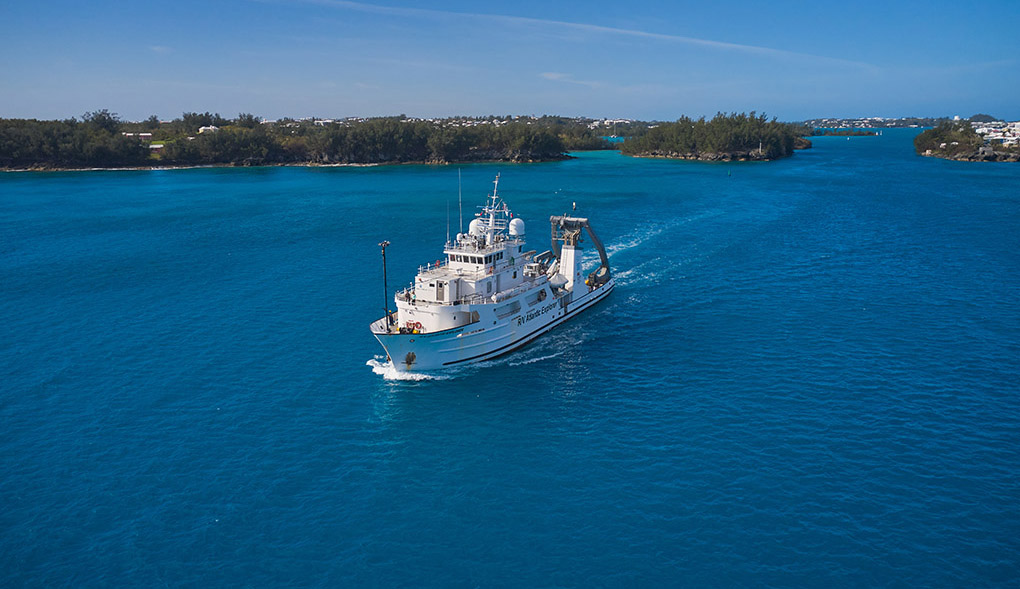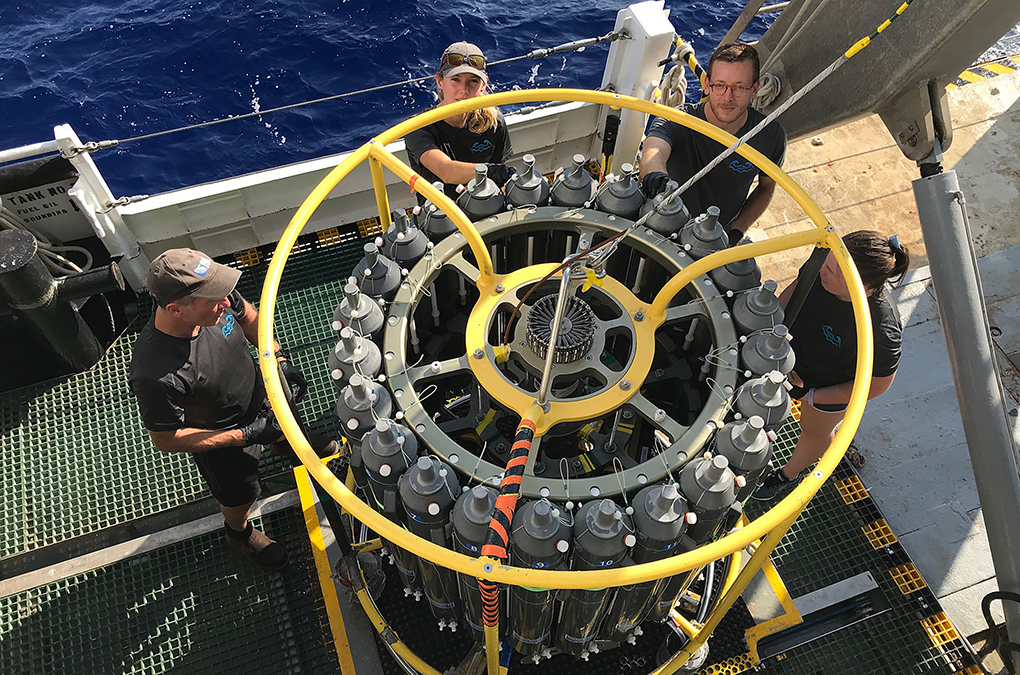Hydrostation ‘S’ Turns 70

Hydrostation 'S' Co-PI, Rod Johnson, who has participated in more than 30 years of cruises, collaborations and research: a testament in his words to the research technicians, principal investigators and support staff.
In the wake of an official forecast linking extreme ocean heat to warnings of an outsized 2024 Atlantic hurricane season, ASU BIOS marked the 70th anniversary of a venerable oceanographic time-series that signaled early evidence of ocean warming decades ago and still feeds our understanding of climate change impacts.
Located 15 miles (25 kilometers) southeast of Bermuda, Hydrostation ‘S’ has enabled ocean sampling by scientists and students since its establishment by Woods Hole Oceanographic Institution (WHOI) oceanographer Henry Stommel on June 7, 1954. Other than a brief gap for equipment repairs around 1980, the station—a set of unmarked geographic coordinates (32 degrees 10 minutes North, 64 degrees 30 minutes West)—has yielded measurements of temperature, dissolved oxygen, salinity and other parameters every two weeks for seven decades.
Supported initially by WHOI, with key involvement by WHOI scientists such as William Jenkins, David Menzel and James H Ryther, Hydrostation ‘S’ data have informed the work of hundreds of international researchers and over 600 scholarly publications. Combined with BIOS’s Bermuda Atlantic Time-series Study, it provides the longest continuous record of warming in the surface ocean.

Time-series plots of temperature (upper panel) and salinity (lower panel) anomaly at 300m for Hydrostation ‘S’ 1955-2023 whereby the anomaly is computed by subtracting the long term mean for this depth. Red line shows a 12-month running central mean and the observed data is shown as blue dots. Statistically significant long term trends for temperature and salinity are shown as black line and determined as 0.018 °C/year (p < 0.01) and 0.002 /year (p < 0.01) respectively.
“To this day, we have the longest-running set of measurements in the open ocean in the world,” said ASU BIOS Associate Research Professor Rodney Johnson, who took his first cruise to Hydrostation ‘S’ days after arriving in Bermuda in October 1988 and is now the station’s Co-Principal Investigator. “The Hydrostation ‘S’ data clearly show significant long-term changes in ocean warming, particularly in the upper 500 meters. We were aware of it back in the ‘80s, of course, but the message was a much harder sell back then.”
Specifically, Hydrostation ‘S’ data reveal that the upper ocean is more than one degree warmer now than 40 years ago. That’s “a significant amount of heat,” said Johnson, who likened the time-series to “connecting the dots” over several decades. The result is “an unparalleled view of how the ocean has changed over the past decades and provides a window into future changes,” said ASU BIOS Senior Scientist and Director of Research Nicholas Bates, who began working on dissolved oxygen and inorganic nutrient samples at Hydrostation ‘S’ in 1986 and became Principal Investigator in 2012.
Besides the steady trend in ocean warming, Hydrostation ‘S’ research has yielded a wealth of other discoveries. Measurements in the early 1960s, for example, produced the first data demonstrating seasonal changes in the primary production (marine phytoplankton growth and biomass) in the open ocean and established the concepts of “new and export production” of organic matter. This, said Bates, has “profoundly changed and influenced the biological/biogeochemical understanding of the ocean.”

Research vessel Atlantic Explorer heads to sea through Town Cut channel. Photo by Andrew Kirkpatrick
“For the first time,” added Johnson, “we could understand how the physics are changing the biology and the chemistry…how the ocean works in a very fundamental sense.”
Scientists have also documented loss of dissolved oxygen over the course of the time-series, as well as increased salinity, lower pH, ocean acidification, and a total turnabout in the ocean carbon cycle.
The upper ocean of the Sargasso Sea in the 2020s has a completely different ocean chemistry compared to the 1980s with ocean biology now operating in pH conditions (and CO2-carbonate chemistry) outside of the chemistry of the recent past,” Bates said. “The pH of the Sargasso Sea is lower than at any time in the past tens of millions of years.”
Considered together, measurements taken at Hydrostation S offer a unique view of environmental shifts that are prime indicators of climate change.
“The things we measure, these are all what we deem as essential climate variables for international ocean observance systems,” Johnson said.
Funded by the National Science Foundation for over 50 years, the work at Hydrostation ‘S’ exemplifies an evolution in oceanographic research methods. When Johnson embarked on his first Hydrostation cruise, Niskin or Nansen bottles were spaced at 13 different depths along a hydro wire. Each bottle had a brass messenger weighing about a pound that would close the bottle once a water sample was collected, then descend to close the next sample and so on.
Each bottle was also equipped with two reversing thermometers – one protected from ocean pressure and one unprotected. When each sample was completed, stems of the thermometers would snap off to record the temperature at that specific depth within a 1,000th of a degree, Johnson said. Once samples were hauled aboard, researchers used the readings from both thermometers to calculate the exact depths at which temperatures were taken. Dissolved oxygen, dissolved CO2, salinity, bacteria, and nutrients are among the other measurements that were recorded on board.

Rod Johnson, Emily Davey (Research Technician), Dom Smith (Research Technician) and Claire Medley (Research Technician) sample the CTD for dissolved O2 and CO2 aboard R/V Atlantic Explorer during a routine cruise.
Johnson’s first trip to Hydrostation ‘S’, cruise number 642, was the final one that used the hydro line method. On his next one, cruise number 643, BIOS for the first time deployed a CTD (conductivity, temperature and depth) device able to gather water column samples at a rate of 24 per second. Still deployed aboard Atlantic Explorer research vessel today, the CTD is an electronic instrument package attached to a rosette with 24 Niskin bottles that researchers can close remotely to collect samples at any depth.
Although Hydrostation ‘S’ is located where ocean depths reach nearly two miles, it is also an easy day trip from Bermuda, “a massively important aspect” given the propensity for winter storms in the Sargasso Sea, Johnson said.
“The wonderful thing about doing oceanography in Bermuda is we’re very close to that deep ocean. It gives us the flexibility to get in and out of storms,” he said.
As a result, research at Hydrostation ‘S’ doesn’t typically have to contend with expensive missed “ship days” that plague deep water research stations located further offshore.
Pioneering discoveries that increase knowledge about issues ranging from changes in global ocean circulation to seasonal variations in phytoplankton notwithstanding, Hydrostation ‘S’ plays another vital role. Research cruises to the study site have allowed hundreds of high school, undergraduate and graduate students to take part in science at sea – inspiring future generations of oceanographers, marine educators and conservationists.
“Hydrostation ‘S’ cruises contribute to the first ‘at-sea’ experience of many students, and to building interest and experience for students considering careers in marine science and STEM subjects," Bates said. "This is very important for improving the access of undergraduate and graduate students to the ocean and encouraging more students to pursue a career in science.”
